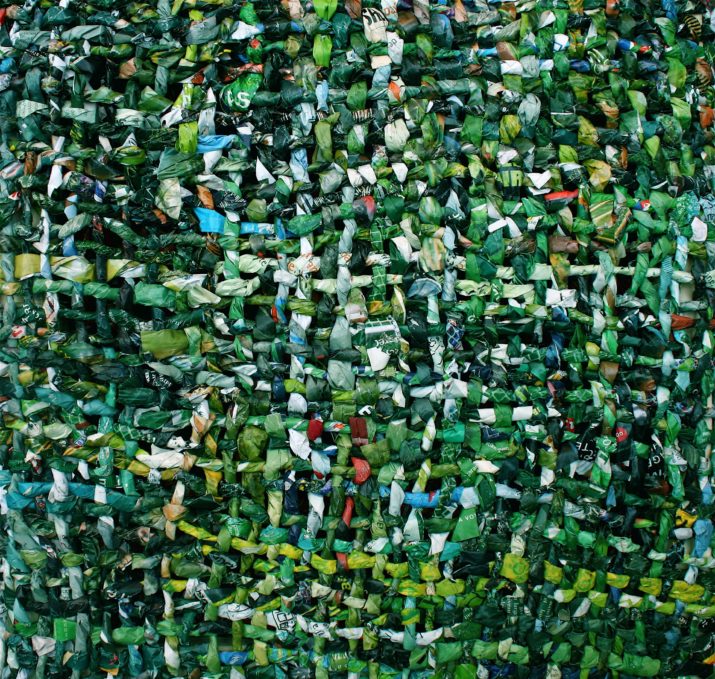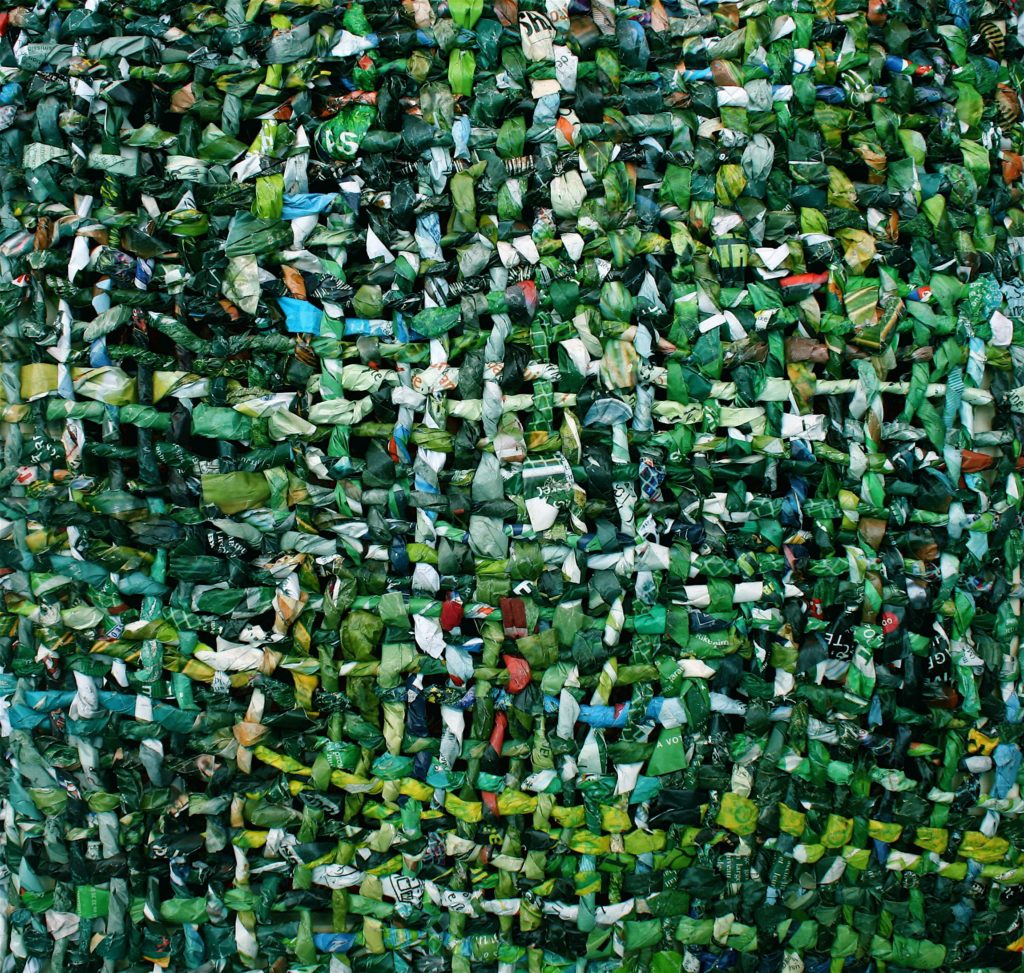

An introduction to our special feature, Confronting Waste.
There are many words in English that describe the refuses of existence, i.e. what is no longer of utility. Trash, garbage, rubbish, junk, litter, detritus, debris, whatever the word or the language, “waste does not lie,”[1] writes Octave Debary (citing Gérard Bertolini 145). As possibly the most sincere form of cultural objects, waste reveals the choices a society has made and continues to make in shaping its relationship with the environment. Waste can also assimilate the idea of wastefulness, which, by introducing a moral dimension of recklessness and culpability, intimates the idea of choice with respect to resource use. In today’s debate over the Anthropocene, waste is often used as a proxy to measure the pressures societies exert on the environment. No corner of the Earth, nor any species, is left out of this debate. Even outer space is said to be saturated with more than 500,000 human-made orbital debris (NASA 2013).
The effects of a global increase in “waste footprint” materialize in heightened levels of pollutants and irritants contaminating the natural environment—air, soil, water—with consequences on ecosystems many species depend on, including humans. Waste has been shown to alter plants and animals’ behaviors and reproductive patterns, leading to potential loss of biodiversity. Landfills and incineration operations, like recycling, further contribute to climate change through carbon emissions and resource use, as well as to environmental injustice through impact disparities across communities. However, one of the most obvious symptoms of trash-induced environmental stress, and a clear sign of our global inability to find durable and viable solutions for the afterlife of the many things we discard as valueless, is the so-called “seventh continent.” This 1.6 million km² trash vortex in the Pacific, constituted of an estimated 80,000 tons of mostly plastic micro-fragments and larger scraps that have been thrown away by humans and brought together by ocean currents, has created a toxic plastic marine ecosystem coined the Plastisphere (Zettler 2013, Eriksen 2013). Along with counterparts discovered in the Indian and Atlantic oceans, the Great Pacific Garbage Patch is evidence that we, as inhabitants of the Planet, have been unable or unwilling to tackle our “waste problem” in spite of policies and regulations being implemented at the international level. When, in 2018, China announced that it would withdraw from waste trading arrangements, according to which it previously imported certain castoffs from other countries, it was yet another summon for rich economies to confront waste urgently. Will we seize this moment as an opportunity to make strides in waste reduction and develop ecological solutions for surplus, unused, and rejected materials of all sorts, or will we simply seek out new trash havens elsewhere in the world?
We have become all-too-familiar with images of massive trash heaps showing accumulated remnants of everyday life. As endpoint consumers, we are constantly reminded of the role we should play in mitigating the waste predicament, from participating in zero-waste programs in the workplace, to learning how to compost in apartment living and banning plastic bags from our lives once and for all. Anywhere we turn, we find advice about how to reduce the volume of household trash through the now 7Rs (Refuse, Reduce, Reuse, Repurpose, Repair, Refill, Recycle), as well as through composting, conserving natural resources, and making overall changes to our consumption habits in order to consume “rationally” or even “intelligently.” However, critically examining waste entails more than questioning and evaluating consumption patterns and envisaging consumers as eco-citizens. It also requires structurally reassessing global production norms and economic systems, as well as interrogating the place of technology in this “alternative world.” Addressing the waste problem, which arguably amounts to a global “crisis,” is a complex affair that cuts across numerous fields of study and areas of practice. If often presented as a primarily environmental question, waste is indeed also at the core of key economic, social, cultural, technological, and political imperatives. Two main approaches have guided policy-making: waste production, which considers the creation of waste by industries along the production process or by individuals through consumption, and waste management, which concentrates on coping with waste once it has been produced, whatever the origin. Moreover, the study of waste—waste studies, discard studies, garbology, or rudology (from the latin rudus for rubbles)—investigates the implications at different scales, from micro-organisms to supra-national organizations. In recent years, with the emergence of several academic journals that focus exclusively on waste, garbage has become a scholarly field in its own right. But, still, waste piles up exponentially. The World Bank predicts a 70 percent increase by 2050 (Kaza et al. 2018).
With this special feature, EuropeNow seeks to encourage a discussion about waste by presenting this vast interdisciplinary topic through a selection of artistic endeavors and research articles. In these pieces, our contributors consider an array of specific types of wastes that researchers have examined, test past and present solutions that have been attempted, and advance some proposals for the future of waste. While the question of rubbish is so broad and encompasses so many aspects of physical, social, political and economic life that it would be impossible to address them all, the contributors assembled here appraise many of the key actors involved in the waste question in the formal or informal sector, whether on the production or consumption side. In doing so, they help further conceptualize waste, supporting the design of crucially needed solutions. To start with, it is necessary to contextualize waste in time and space. If we consider waste as a mirror of a society’s values about material culture, tracing waste historically is essential to gaining an informed grasp of contemporary societal reactions and political and economic engagements vis-à-vis trash production and trash management. As environmental historian Thomas Le Roux highlights in his interview with EuropeNow, societies’ concern with materials that are no longer desired or needed—whether solid or atmospheric—is nothing new. Though it would be tempting to believe that waste became an issue with the first industrial pollution externalities, he makes clear that pre-industrial societies were already preoccupied with their rejects. However, industrialization and urbanization would certainly change the scale and nature of waste products, as would later on the invention of single-use items, which greatly contributed to the polymeric accumulation in landfills and oceans. Also following a historical approach into the topic, Myra Hird and James Wilkes reveal the links between waste and a long-lasting colonial ethos of land use and cycles of production-consumption, which started with Europe’s first encroachment into new territories across the world. Arguing that waste is today a symptom of a long-rooted colonial conception of land and life, the environmental scientists see resource extraction and disregard for harm as key drivers in the wastification of the planet. Their reasoning encourages a reconceptualization of the circulation of materials as to include an economy of care that demands an attentiveness to indigenous peoples.
The fast-growing field of environmental humanities is testimony to the vital role the arts and literature have to play in how we understand and tend to the environment. Discarded plastics and other reclaimed materials have been used by artists as creative resources to induce viewers into reconsidering wastescapes and trigger awareness about individual and collective responsibility. “Second Chance, Last Chance,” the visual exhibit highlighted in this special feature, underlines that educating about the global trash problem is no longer the monopoly of policy-makers, associations, and academics. By making art from trash, environmental “artivists” not only capture and domesticate a new medium, but also put the accent on the ways in which trash should be reinvented as something with value based on its intrinsic material and temporal mnemonic quality. This “recyclart,” also called “eco-art,” acts all at once as a repurposing exercise, a critique of unbridled and unreasoned overconsumption, and a pedagogical project demonstrating possibilities and resolve. Literary studies have not been absent from the humanistic approach to trash either. Both Susan Morrison and Deborah Wynne show that waste studies are a useful lens for textual analysis in twentieth and nineteenth century writings, respectively. By delving into memory, status, social contamination, and more generally the ethics and aesthetics of waste in literature, they engage readers into the imaginary of filth, rot, and rags, inviting a reflection on the ways in which trash creates and sustains inequalities, as well as the value of waste in exploring issues of remembrance, decay and ruin through metaphors.
One recurrent question in dealing with waste is to determine the role of the individual and the scale at which best responses might emerge. Isabelle Hajek exposes the ways in which citizens, grassroot associations, and transnational movements have mobilized around an “ecology of personal solutions” to develop ideals and norms in the face of mounting waste. She shows how, from freeganism to dumpster diving, people have aimed at changing their relationship with the material, supported in their quest by social media and transnational networks. Her work brings the question of intersecting scales to the fore. While every consumer’s determination counts, how could these efforts be scaled up to whole communities or even whole cities? Nevertheless, even for probable skeptics, Hajek’s work is a welcome indication that individuals, at least in the global North, are getting organized outside of national or international policy. However, one of the main remaining problems is that of blatant inequalities in front of waste and the ways in which differentiated waste management produces unequal risk, especially when it comes to toxic wastes, with stark differences across world regions.
In Europe, one defining moment was shaped by the 1986 Chernobyl disaster, which would leave an indelible trace on the public psyche about the dangers of radioactive waste and is still feeding popular imagination, for example through a very recent TV miniseries co-produced by the US and the UK and advertised as relating to “one of the worst man-made catastrophes in history — and the sacrifices made to save Europe from unimaginable disaster.”[2] Away from sensationalism and dramatization, Tatiana Kasperski explains how the disaster, in the context of the Berlin wall coming down shortly after, provided an opportunity for cross-boundary harmonization of nuclear waste policy between East and West, and granted an expanded role to the EU in waste management, thus changing the scale of response as states were made to adapt to regulations as part of negotiations for membership consideration. The Chernobyl case provides the EU and others with an opportunity to learn from successes and failures, and to transfer this knowledge to the treatment of other types of waste, toxic or not. For instance, another category of waste is the soaring amounts of electronic waste, which contains complex alloys that are difficult to separate. While the readily-available narrative often preconceives that e-waste is the poster child for waste-driven geographic inequalities, as it is dumped in poor countries in the global South, Josh Lepawsky argues that this assertion needs to be seriously mitigated. Data shows that an inflated focus on end-user e-recyclables and e-waste dumping in developing countries in fact conceals another alarming reality, i.e. the massive scale of the problem on the production side in rich economies. Going against conventional wisdom, he contends that emphasizing consumers dangerously exonerates industries, masking externalities caused by the production of electronics. Advocating for a wider definition of e-waste, he proposes the implementation of policy aimed at shifting responsibilities to the industrial sector. While Hajek demonstrates increased individual agency in shaping the ways in which societies confront waste, Lepawsky problematizes that response, showing that consumer choices for reduced waste options may be almost irrelevant and inconsequential in some sectors of the economy, and that waste requires the development of adequate industry-wide answers as well.
Is this mobilization enough for us to be hopeful? Will we see “peak garbage” in our life time? As a species, are we condemned to become homo detritus (Le Lay 2016) in an unavoidable “Trashocene?” Many of the solutions that have been proposed and tried have already shown their limits. Even the circular economy has its detractors. However, Megan Blake’s article provides us with a glimmer of optimism in this otherwise bleak global trashscape. Indeed, she is concerned with the ways in which surplus objects—here food commercially produced in excess—leave the commercial arena to be redistributed, as well as the ways in which commercial supply chains intersect with not-for-profit networks. The actors driving this dynamic of “unwaste,” the discourses behind it, and the sites of practice all encourage the development of new relationships with edible materials while simultaneously positively affecting social connectivity. At this particular juncture, in which—even in developed economies such as the UK—collective pantries and foodbanks usage and demand are soaring, Blake’s work on surplus food delivers avenues for meaningful applications as it partakes in the wider discussion on the circular economy. Directly addressing circularity in this feature are Salman Zafar and Willi Haas. While waste-to-energy consultant and “ecopreneur” Zafar—embodying an illustration of practitioners’ work—explains the energy-producing prospects lying in the transformation of biodegradable waste into biomethane, Haas discusses resource flows and cycling of non-renewable materials and energies. Taking into account the finiteness of raw materials, the latter advocates for a retooling of the ways in which waste has been apprehended towards instead a system perspective that also promotes limiting final waste internally within economic sectors. Furthermore, Haas poses the challenging question of measuring Europe’s circularity to assess potential results deriving from policy. In this material accounting endeavor, he provides some answers about how to differentiate biomass ecological cycling from socioeconomic cycling that often falls onto consumers through the familiar 7Rs. Noting the obstacles standing in the way of making economies more circular, Haas also puts in the balance resource scarcity, the illusion that technology will offer a quick fix, and the inadequate relationship between states, businesses, and individuals.
What these studies all show is that addressing global trash is a constant exercise in scale-hopping, and that all actors, humans and non-humans, represent interconnected links necessary to the activation of a long chain of interrelated practices, in which individuals, neighborhood associations, industrial sectors, or the European Union as a whole all have a part to play in decision-making and implementation. In going beyond the common but now too simplistic adage of “reduce, reuse, recycle,” we need to instead muster a compelling legal and political response and intensify our focus onto producers, which does not mean leveling off the pressure on consumers to behave ecologically. Artists, scientists, and thinkers in this special feature are part of a global mobilization of every instant, everywhere in the world, at one level or another. This can give us some hope that social perceptions of rubbish are not fixed, as we also know that culture is malleable. A future is slowly being outlined, in which the hidden cost of waste is accounted for and the implications—in terms of standards of living for example—are better identified and made legible. Staying away from doomsday narratives is important to keep all possibilities open and sustain action. Our role as scholars is at least to help societies become more cognizant and critical of waste as an environmental disruptor of great magnitude in the longue durée. Indeed, most accumulated byproducts of our daily lives will amply survive us.
Research
- “Waste in Literature and Culture: Aesthetics, Form, and Ethics” by Susan Morrison
- “Colonial Ideologies of Waste: Implications for Land and Life” by James Wilkes and Myra Hird
- “Radioactive Waste Challenge for European Integration and Enlargement: Soviet Nuclear Legacy in Central and Eastern Europe After 1989” by Tatiana Kasperski
- “The Multiple Ontologies of Surplus Food” by Megan Blake
- “Europe Has E-Waste Problems: Exporting to Africa Isn’t one of Them” by Josh Lepawsky
- “From Throwaway Society to Circular Economy: Solution or Comforting Illusion?” by Willi Haas
- “Brokers in the Fight Against Waste” by Isabelle Hajek
Interviews
- “Textile Recycling in Victorian Literature: An Interview with Deborah Wynne” by Hélène B. Ducros
- “Approaching Waste through Environmental History: An Interview with Thomas Le Roux” by Hélène B. Ducros
Visual Art
Reviews
Campus
The Daily
Editor’s Pick
Hélène B. Ducros is Chair of Research and Pedagogy at EuropeNow. She holds a JD (Law) and PhD in human geography from the University of North Carolina-Chapel Hill. Looking at cultural landscapes historically, she has been interested in wastes and vestiges as cultural objects and traces left behind. Through her travels around the world, she has been fascinated by creative reuse, recycling, upcycling, whether functional or artistic, and is interested in people’s inventiveness at giving materials renewed meanings. At UNC-Wilmington, she created and designed the interdisciplinary course on “Global Garbage, Trash, and Solid Waste.”
References
Debary, O. 2019. De la Poubelle au Musée, une Anthropologie des Restes. Paris: Créaphis Editions.
Eriksen, M., 2013. The plastisphere-the making of a plasticized world. Tul. Envtl. LJ, 27, p.153.
Kaza, S., Yao, L., Bhada-Tata, P., Van Woerden, F. 2018. What a Waste 2.0: A Global Snapshot of Solid Waste Management to 2050. Washington, DC: World Bank. https://openknowledge.worldbank.org/handle/10986/30317
Le Lay, S. 2016. L’homo detritus fait-il de la politique: Quelques réponses sous forme de mégots de cigarettes. Mouvements, no 87(3): 25-35.
National Aeronautics and Space Administration (NASA). 2013. Space Debris and Human Spacecraft. https://www.nasa.gov/mission_pages/station/news/orbital_debris.html
World Bank. 2018. What a Waste 2.0: A Global Snapshot of Solid Waste Management to 2050.
Zettler, E.R., Mincer, T.J. and Amaral-Zettler,
L.A., 2013. Life in the “plastisphere”: microbial communities on plastic marine
debris. Environmental science & technology, 47(13),
pp.7137-7146.
[1] Translation by author.
[2] Trailer available at https://www.hbo.com/chernobyl
Published on May 7, 2019




